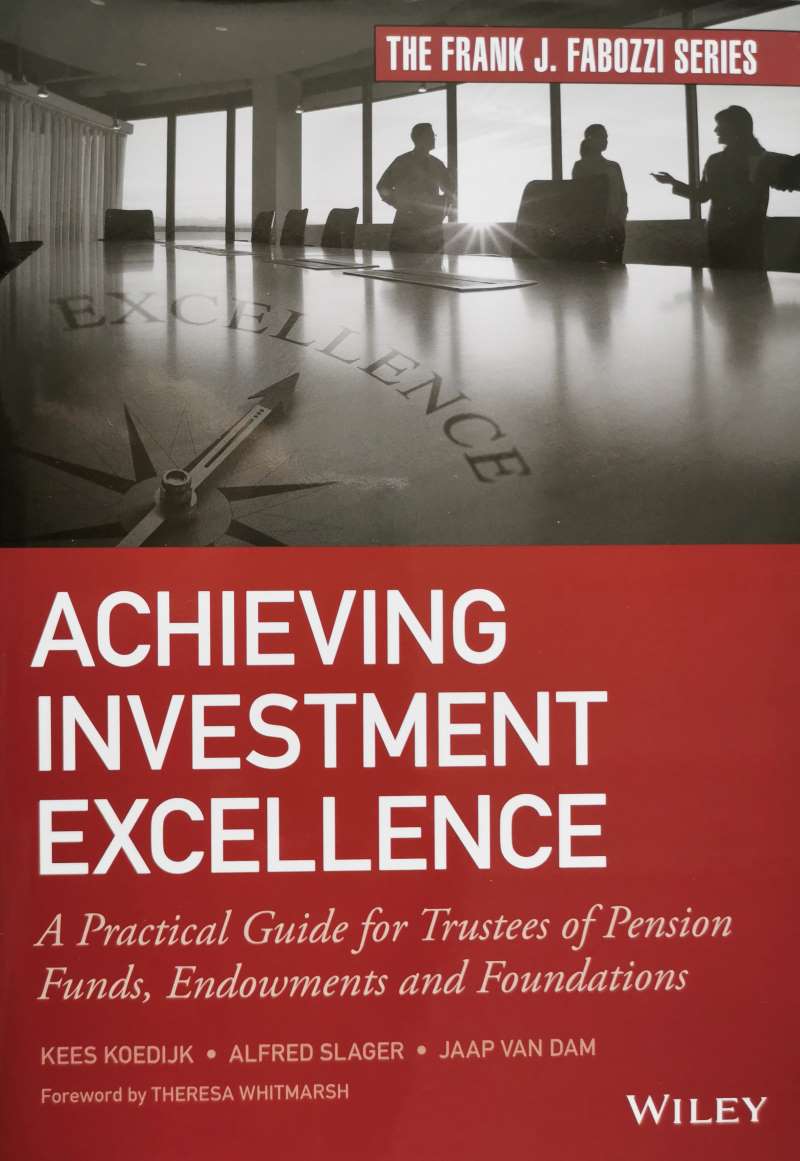Whether you are reading this review, because you are almost certainly a trustee or board member, or perhaps you are considering becoming one, I cannot foretell. The first sentence of this interesting and somewhat unique book starts just like that – so it's almost a quote (replace review by book) - outlining its potential audience. That seems to unduly limit its readership, a pity, as the book contains so many valuable thoughts, observations, reflections, and recommendations. Which, in turn, summarizes my personal assessment of the book: nuanced thinking about how to achieve excellence, distilling many years of experience into valuable insights and guidelines, and encouraging a longer-term and reflective approach to dealing with the mission you might have with or within a pension providing institution.
That is why the scope and relevance of the book goes way beyond trustees or board members. Therefore, it is less of a 'practical guide', as the subtitle would make you believe. The book is published in a very prestigious series ("The Frank J. Fabozzi Series" of Wiley), which I think is boon and bane at the same time: it 'deserves' a much lower price, to have a broader reach and readership. Whether the sales figures for the book will prove my point, I cannot foretell. What I can tell is what you will find in the book, and – that's the nature of a review – where I think the authors have 'achieved excellence' in the presentation of their thoughts, yet likewise emphasizing where I had difficulty collecting the 'return' of the contents.
The 300 pages come across in a rather thin hard-cover book, with full pages of small print, so you will have many hours of interesting reading. This 'practical guide' contains a lot, presented in 13 chapters, with a concluding 14th – which the authors suggest you may read first, and they reward you right away: "Congratulations! You have almost finished the book." (p. 255) I did follow this recommendation: for me, it wasn't a good advice… I got lost, and could never return to reading the chapters in a disciplined fashion in their original line-up: a variety of absorbing topics make you start reading and re-reading here and there. As is obvious from their headlines, they cover an outrageous wide territory, and make you want to start delving into it right away:
1 The Role of Pension Funds, and the Role of Boards
2 Developing Purpose, Mission, Vision, and Goals
3 Grasping the Investment Essentials
4 Investment Beliefs as Guiding Tools
5 Designing the Investment Management Process
6 Organizing the Investment Function
7 Implementing the Investment Strategy
8 Building the Investment Portfolio
9 Monitoring and Evaluation
10 Becoming an Effective Board
11 Establishing the Investment Committee
12 Managing the Investment Organization
13 Learning to Decide and to Take Advice
14 Achieving Investment Excellence
In between some of these chapters, the authors have inserted seven case studies of well-known pension funds from all over the globe (GEPF South Africa, PFZW/PGGM The Netherlands, New Zealand Superannuation Fund, GPFG Norway, ATP Denmark, OTPP Canada, CalPERS USA, Future Fund Australia). However, these are all covered in less than three pages each, and you wouldn't know why they feature where they did, and what the relation was to what you were being told in the previous chapters (except for the somewhat critical analysis on CalPERS). The examples seemed to me a bit 'disconnected'.
Connected, and disconnected, are terms which I would use as catch phrases to describe what is excellent in the book, and what I found difficult. First, as is clear from the chapters list, the authors address almost every angle of a trustee's or board member's responsibility for a pension fund – and for that: an endowment, or similar investment organizations. They connect the objective of achieving long-term investment results with perspectives from strategy definition, technical implementation, and organizational issues. They address e.g. board room dynamics, behavioral issues, consider managing the different stakeholders, and thereby blend the 'practical guide to investment' with something you would find in the management literature. The spectrum is from debating the advantages of active vs. passive management, to the problems of groupthink in committee meetings. The authors succeed to make you fully aware of how much technical jargon (pre-)determines what you will see in the asset management and pension industry. They show how much of all this may in fact prevent implementing clear-cut responsibilities, and well-defined 'deliverables' by the different departments, committees, stakeholders, and so forth. This connecting and encompassing perspective makes reading each chapter a rewarding pleasure.
Yet, at the same time, that may well be one of the reasons why I had sometimes difficulty navigating the contents, assuming that the book was a 'practical guide'. At times, you just get lost, you don't really know what is being addressed – maybe too many important issues at the same time? – and you may enjoy the feeling that things get a bit repetitive. Now, if and when addressing qualitative and 'managerial' issues, one has to bridge between the trivial, and the subtle issues in dealing with organizations. But even though the book is divided and subdivided in dozens of chapters, sections, and subsections, with boxed key-take-aways and summaries, and three- to four-fold introductions as to why what is when presented…. I could not find the general 'leitmotif' – however, we all acknowledge that 'achieving investment excellence' is not a one-dimensional exercise. Presenting the material in university textbook-style might have been the cause for some of my discomposure. This instructive book contains a very seasoned and high-level analysis of our industry and practices; just a question of how to offer that more coherently.
The authors have, notwithstanding, achieved something very rewarding: to get away from discussing the title's objective simply in terms of alpha and beta, asset classes and track records and so on. Instead, they design and present an integrating, nay holistic view. You get a condensed discourse of many years of experience with managerial, organizational and behavioral issues. Reading through the manifold sections and subsections, you will enjoy often times your own experience being put into perspective, and many a good argument for your next committee meeting.

Das Buch: Achieving Investment Excellence. A Practical Guide for Trustees of Pension Funds, Endowments and Foundations
Wiley, The Frank J. Fazozzi Series, Chichester, 2019. 320pages.
Die Autoren: Kees Koedijk, Alfred Slager, Jaap van Dam
Der Rezensent: *Dr. Oliver Roll ist Strategie- und Vertriebsberater (4AlphaDrivers) und Niederlassungsleiter Deutschland von Pareto Asset Management, Oslo.
Buchbesprechung: Kees Koedijk, Alfred Slager, Jaap van Dam: "Achieving Investment Excellence"

Dr. Oliver Roll
